
2015.2 | 2015.1 | 2014.2 | 2014.1
2013.2 | 2013.1 | 2012.2 | 2012.1 | 2011.2 | 2011.1 | 2010.2 | 2010.1
2009.2 | 2009.1 | 2008.2 | 2008.1 | 2007.2 | 2007.1 | 2006
August – December 2009
- December 2009 Newsletter – December 3
- October 2009 Newsletter – October 5
- August 2009 Newsletter – August 11
December 2009 Newsletter
Shows and Sales
- Bonhams Natural History Sale – December 6, 2009
- Tucson Time – February 2–14, 2010
- Munich 2009: A Report from Pala’s Will Larson
Pala International News
Mineral and Mineralogy News
- Tuesday, December 1st – Oceanview Adventure
- Chips & Chunks
- California Gold Prospecting Pictorial
- Ronald Ringsrud in SoCal
- The Recycle Bin – items from Pala’s Gem News
- Field Museum’s Grainger Hall of Gems Reopens
- Of Rubies and Wrekin Balls… The “Gem of Tanzania”
Shows and Sales
Bonhams Natural History Sale – December 6
From miniatures to museum pieces…
On Sunday, Bonhams and Butterfields, Los Angeles, offers over 100 fine mineral specimens. According to the estimates, holiday shopping can be affordable, with several lots starting out in the $250–$350 range. Many of such lots come from the “Property of an Encino, CA Collector.” Named names, such as Grieger’s of Pasadena (Lot 2185) and Robert Pogats of La Jolla (2188 and 2195), will be familiar to collectors who’ve done their homework. Fifteen rough-and-cut combos are offered, several at estimates designed to please. But if money is no object, perhaps the “largest known thunderegg in the world” (2067).
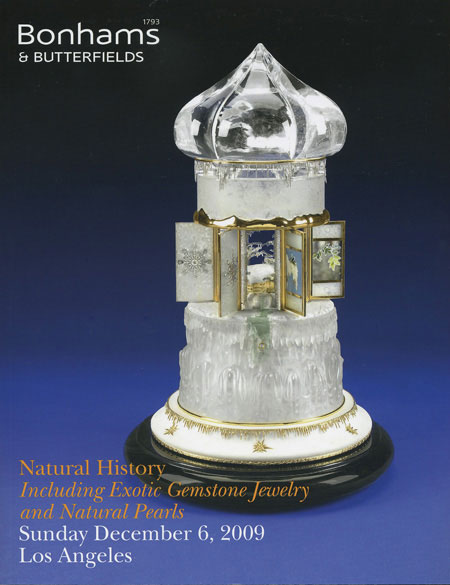 |
The sale also features several carvings, such as a 145-lb. lapis lazuli sculpture (2079) and “The Winter Palace” music box fashioned from rock crystal, diamonds, and aquamarine, pictured on the catalog’s cover above (2096). Among the mineral specimen highlights:
- “The Bonsai Tree” crystallized gold on quartz, from the Eagle’s Nest Mine in California’s Placer County (2106)
- Two “Yowah Nut” opals, from Koroit, Queensland (2138 and 2139)
- Many specimens from the collection of the well-known Massachusetts collector, the late Prof. Marvin D. Rausch, including gorgeous blue-green fluorite twinned crystals (2144)
- A rare 5.25-inch Ukrainian heliodor from the famous Wolodarsk-Wolynskii pegmatite district (2149)
- A mind-bending rhodochrosite slice from Catamarca, Argentina, about which the catalog states, “One should not expect to see a comparable specimen on the market again” (2180)
- Another rhodochrosite, this a large cabinet specimen from the now-closed Sweet Home Mine in Colorado’s Park county (2203A)
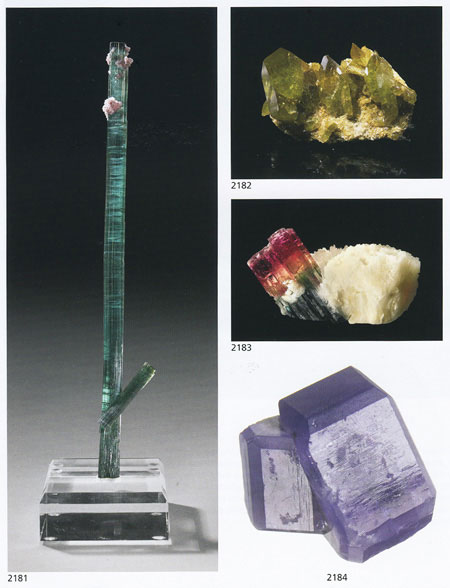 |
| A single page from the Minerals section of this Sunday’s sale catalog shows the diversity of the Brazilian offerings, from a 9-inch tourmaline crystal at left (Pederneira) to the gemmy sphene miniature (Capelinha, Minas Gerais) and the multicolored tourmaline on bladed albite (Urubu Mine). The apatite crystals at lower right are from Oxford County, Maine. (Image © Bonhams 1793 Ltd.) |
View the complete catalog. [back to top]
Tucson Time – February 2–14, 2010
After the holidays, we’re looking forward to the world’s greatest gem and mineral show in February. One-stop general information about individual shows can be obtained from the Tucson EZ-Guide.
Pala International will be represented in Tucson as follows. We look forward to seeing our many friends there. Visit the Pala International Show Schedule for future events.
AGTA GemFair
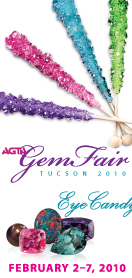 |
Pala joins nearly 100 exhibitors for this annual extravaganza. Some highlights from the schedule that may interest mineral lovers and dealers:
- Books for Gem Lovers features three authors we’ve spotlighted in Pala’s Gem News in recent months: John Koivula, Ronald Ringsrud, and Richard Wise (Thu)
- Cindy Edelstein, of Jewelers Resource Bureau, explains how to use social networking tools (e.g., Facebook, Twitter) to promote your products (Thu)
- Robert Weldon, of Gemological Institute of America, documents the world of ametrine in easternmost Ángel Sandoval Province of Bolivia, with videography by GIA’s Pedro Padua (Thu)
- Alan Hodgkinson regales with “Intriguing Gem Stories” (Fri)
- Edward Boehm, of JOEB Enterprises, on “Spinel: A Royal Gem” (Fri)
- Leela Hutchison, of Leela’s Divine Play of Gemstones, explores those amazing selenite caves of Naica, Chihuahua, Mexico, which we covered in 2007 (Sat)
Event: AGTA GemFair
When: February 2–7
Where: Tucson Convention Center
Booth: 1016–1018
9th Annual Westward Look Mineral Show
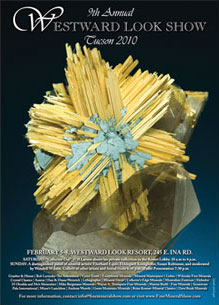 |
Pala International and two dozen other world-class mineral dealers shack up at a Sonoran Desert resort.
- Collector Day (Sat) features Pala’s Will Larson and selections from his Japan and worldwide collections (see this preview from our October edition)
- Mineral Artists (Sun) looks at the work of special guests Eberhard Equit, Hildegard Könighofer, Wendell Wilson, and Susan Robinson, as well as others whose paintings and illustrations will be displayed. Gamini Ratnavira, illustrator of our featured mineral specimen this month, will be included in the exhibition
Event: 9th Annual Westward Look Mineral Show
When: February 5–8
Where: Westward Look Resort
Suite: 236
See Pala International’s page on the Westward Look Show site.
56th Annual Tucson Gem and Mineral Show
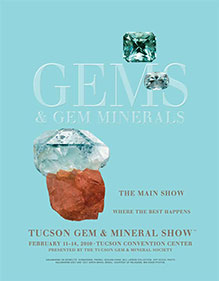 |
TGMS is the largest gem and mineral show in the country. This year’s theme is “Gems and Gem Minerals”—a Pala International specialty.
Event: 55th Annual Tucson Gem and Mineral Show
When: February 11–14
Where: Tucson Convention Center
Booth: Aisle 5 East
Ronald Ringsrud has informed us that the Geo-Literary Society will host a book signing (Emeralds, A Passionate Guide) and lecture by Ringsrud in the Crystal Ballroom at the Tucson Convention Center during the TGMS, Friday, February 12, at 3:30 p.m.
The next day, Saturday, February 13, Richard Wise will appear at TGMS at 11:00 a.m., with a signing (The French Blue) and talk on “The History and Mystery of the Hope Diamond.” [back to top]
Tucson Transit Tips
The I-10 Widening Project is complete; therefore the Gem Ride shuttle is discontinued. Many shows, however, will offer their own shuttles. View your transit and parking options here. [back to top]
Munich 2009
A Report from Pala’s Will Larson
Hammering, drilling—the high-pitch construction noises swirl around my ears as showcases and displays are set up. A construction painter colors the INDIEN sign green to match the theme of the exhibit. Set-up was going smoothly Tuesday, the 27th of October. The floors were empty of clients and collectors, an eerie feel to a place normally so crowded. But by the next day the uncanny feeling vanished.
So begins Will Larson’s report on this year’s Munich show, Mineralientage München. Read the full report here.
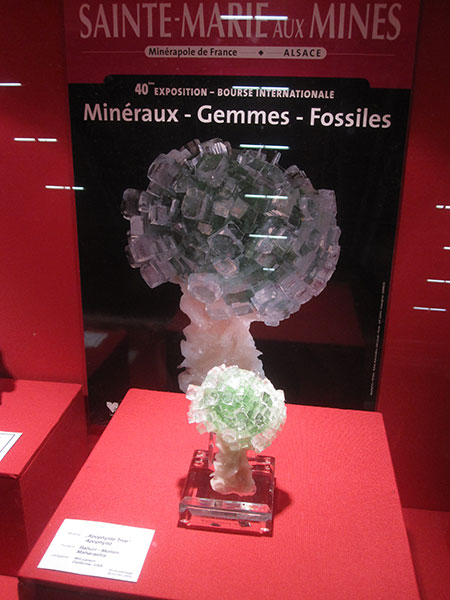 |
| Sainte-Marie or München? Bill or Will? The “Apophyllite Tree,” above, from the collection of Bill Larson, was indeed exhibited at Munich this year. It also happened to grace the poster for the Sainte-Marie show in 2000. From the special exhibit, “India’s Hidden Natural Treasures.” (Photos: Will Larson) |
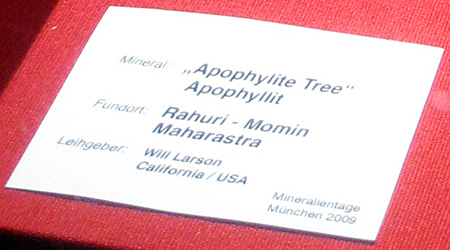 |
[back to top]
Pala International News
Pala’s Featured Mineral Specimen: Epidote
This month we feature an intricate cluster of epidotes from Knappenwand and add a layer of interest by supplementing the beauty of morphology in a painting by Gamini Ratnavira.
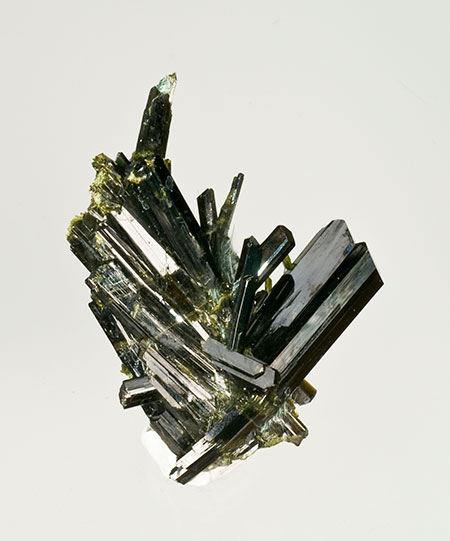 |
| Knappenwand epidote, 6.1 x 4.4 x 1.8 cm. Price available upon request. (Photo: Jason Stephenson) |
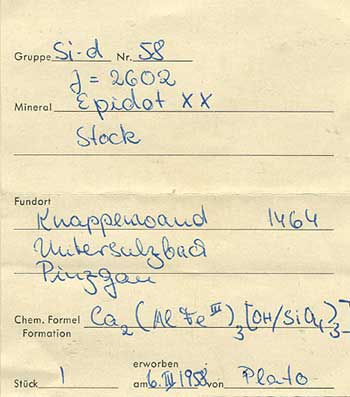 |
This pristine epidote embodies the essence of the great black crystals that have made the Knappenwand mine in central Austria such a famous locale. A 3-cm. crystal anchors this specimen on the right, and a beautiful fan illuminates the piece on the left. Slender jet-black crystals flower out of the center, terminating in lustrous black caps to the right and ending in fibrous green to the left.
For more information on this Austrian locality, see our previous epidote offering from June 2007. And visit our mineral search for a selection of epidotes from around the world.
Interested? Email us or give us a call. [back to top]
Gamini Ratnavira: Mineral Artist
Artist Gamini Ratnavira is a Fallbrook neighbor to Pala International. While he is well known for his paintings of tropical wildlife, in mineral circles his renditions of mineral specimens are valued as well. Gamini’s work will be featured at the upcoming Westward Look Mineral Artists exhibition in February. The following biographical sketch will give insight regarding his craft.
Gamini Ratnavira was born and raised in tropical Sri Lanka. Gamini comes from many generations of fine jewelers, as Ratnavira means “hero of gems” and members of his caste were jewelers to the Kings and Queens of Sri Lanka. Gamini’s father, Sardha Ratnavira, was the first Asian to qualify at the Gemological Institute of America, in 1937–1938, when it was still in Los Angeles.
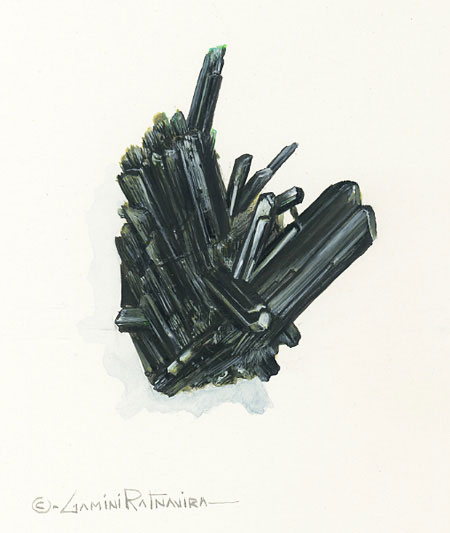 |
| Gamini’s painting accentuates the character of all the individual crystals of our featured specimen, capturing every little face and striation. A little masterpiece to accompany earth’s complex symmetry. (Illustration: Gamini Ratnavira) |
Growing up near the mines in Ratnapura (“city of gems”), Gamini developed an eye and appreciation for minerals and began painting tourmalines in the 1980s for a forthcoming book by Bill Larson. Additionally Gamini has painted dozens of originals for the renowned mineral dealer Dr. Rob Lavinsky and appears annually at the Tucson Gem and Mineral show.
As a self-taught artist Gamini uses his photographic memory and life experiences to produce vibrant, colorful images of the rain forest flora and fauna, which are complimented with intriguing stories and research information about each painting. His paintings reveal his love for art coupled with an unrestrained, lifelong reverence for nature. As a renowned wildlife artist who has traveled to over 40 countries, accumulating a bird list in the 4,000s, Gamini’s artwork continues to honor endangered species and represents a lifetime of honoring nature. Internationally collected, his artwork can be visited at his website and at his gallery on BlueCap Productions. [back to top]
Mineral and Mineralogy News
Tuesday, December 1st – Oceanview Adventure
Earlier this week, Will Larson happened to be in the right place at the right time, and tells us about it…
Nothing like starting off the new month with a bit of excitement! Last month when I visited the Oceanview Mine, the pegmatite had the early signs of showing some richness: a little bit of lepidolite here and some black tourmaline there. But two blasts later and about ten feet deeper—it is rich. Purple showing everywhere all along the left wall, and big black tourmalines in the vein.
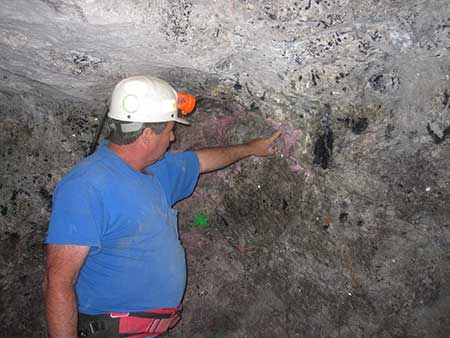 |
| Purple and black. “Purple showing everywhere… |
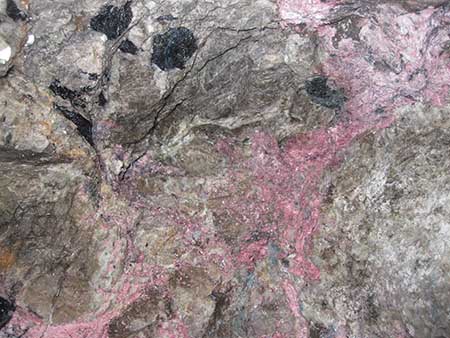 |
| …and big black tourmalines in the vein.” (Photos: Will Larson) |
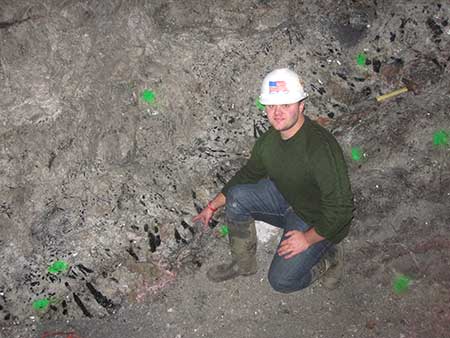 |
Jeff Swanger and his motley crew have already excavated some small pockets, which divulged small kunzite crystals, some etched morganites, and black to green tourmalines. A few more feet and it could turn into something really exciting.
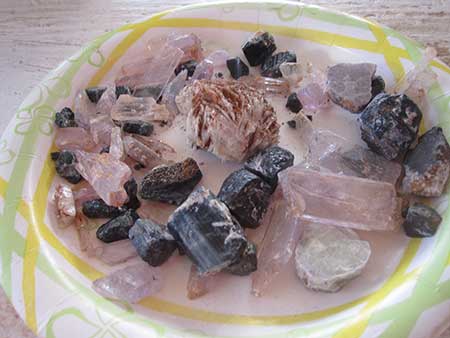 |
| Stone soup. “Lucky guests at the screen tables.” (Photos: Will Larson) |
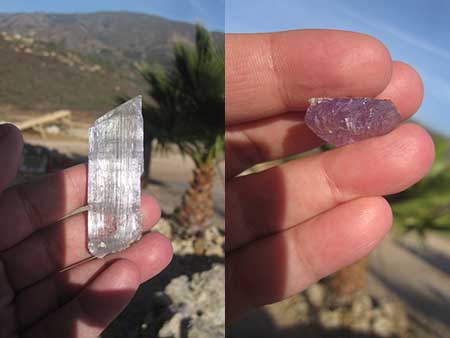 |
Earlier last week some lucky guests at Jeff’s screen tables (see digforgems.com) found a beautiful bicolor tourmaline believed to be from this area! Hopefully some more lucky guests in the coming weeks will find what Jeff misses. [back to top]
Chips & Chunks
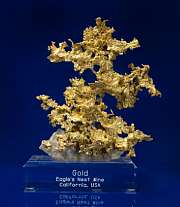 |
| Bonsai. This delicately shaped gold on quartz is offered in the Bonhams sale Sunday. (Photo © Bonhams 1793 Ltd.) |
California Gold Prospecting Pictorial
The recession has brought new fortune hunters to tried-and-true gold prospecting spots in California, such as the San Gabriel River, which flows (several dams notwithstanding) from a source a few miles northeast of Azusa. The relatively mild climate has allowed some folks to take up residence near the site of their search.
While prospecting is “old as the hills,” individuals now take advantage of newer, mechanized methods, allowing them to move beneath the riverbed. Indeed, sales of mining equipment have bucked the recession, according to a BBC photo essay released last month.
The ten-photo slide show depicts oldtimers and newcomers engaged in a variety of techniques for a variety of purposes. [back to top]
Ronald Ringsrud in SoCal
Southern Californians will have two chances this month to see Ronald Ringsrud, author of Emerald, A Passionate Guide, at Nevada Mineral & Book Company, 342 S. Tustin Street, Orange, CA 92866.
- Friday, December 18: Book signing 5–9 p.m., with a one-hour lecture and slideshow at 7:30
- Saturday, December 19: Book signing 10 a.m.–12 noon with a one-hour lecture at 11 a.m.
In the spirit of the season, a raffle will be held each day for a half-kilo of Colombian coffee beans that Ringsrud will bring back from his December trip to the Bogotá emerald market and Colombian emerald mines. Mineral specimens of emerald will be on display and for sale. Colombian coffee will be served.
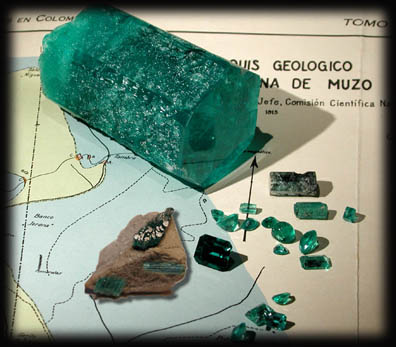 |
| Stocking stuffer. Ringsrud will have emerald mineral specimens on hand for display and sale at his Southern California appearances this month. (Photo courtesy Ronald Ringsrud) |
[back to top]
The Recycle Bin
Here we point to items from Pala’s Gem News that pertain to mineral enthusiasts…
Field Museum’s Grainger Hall of Gems Reopens
Chicago’s Field Museum of natural history has unveiled its newly expanded Grainger Hall of Gems, which University of Chicago Press publicist Mark Heineke says “will rival the collection at the Smithsonian in value and sheer breadth.” A companion volume also has been released—Gems and Gemstones: Timeless Natural Beauty of the Mineral World. Read about both here.
Images from the book follow…
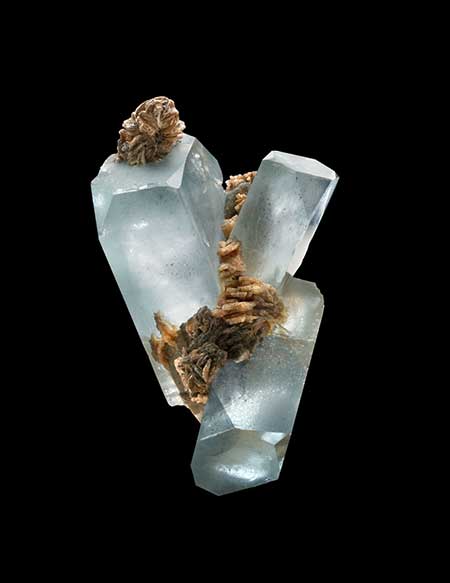 |
| Natural blue faceting-grade topaz crystals on matrix from near Alabashka, in the Ural Mountain region of Russia. Specimen is 100 mm. in height . (Photo courtesy University of Chicago Press) |
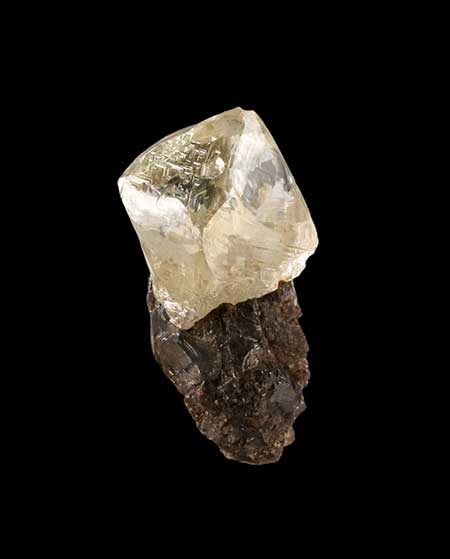 |
| Large gem-quality natural diamond crystal on bort matrix. The colorless gemstone material is a high-quality, colorless octahedral crystal weighing 26 carats and measuring 18 x 17 mm. Specimen was originally discovered in Kimberley, South Africa. (Photo courtesy University of Chicago Press) |
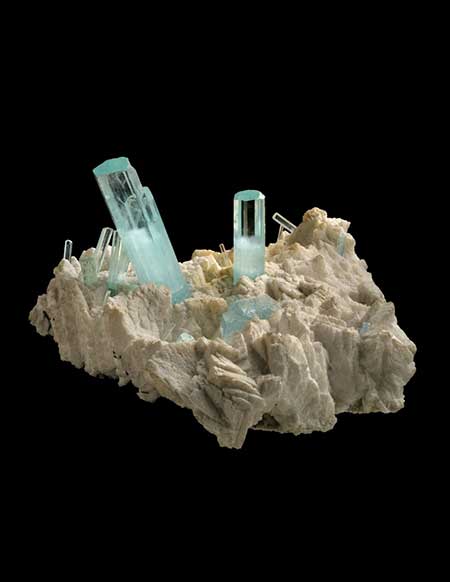 |
| Natural aquamarine crystals in white albite feldspar matrix, from the Gilgit district, Pakistan. Length of largest crystal is 70 mm. This specimen decorates—and handsomely so—the cover of Gems and Gemstones: Timeless Natural Beauty of the Mineral World. (Photo courtesy University of Chicago Press) |
[back to top]
Of Rubies and Wrekin Balls
 |
If the Bonhams sale on Sunday fails to capture your fancy, consider another sort of storied stone: the “Gem of Tanzania.” Once valued at £11 million by the UK’s Wrekin Construction [sic], the rough crystal likely will fetch a fraction of that sum.
If you liked the “Bahia Emerald,” you’ll love the “Gem of Tanzania.” See our story, “Of Rubies and Wrekin Balls.” [back to top]
— End December Newsletter • Published 12/3/09 —
October 2009 Newsletter
Shows and Sales
- Mineralientage München: October 30–November 1, 2009
- Specimens with Altitude: A Report from Denver
- Lyon Mineral Show Features Famous Larson Specimen
- Sainte-Marie-aux-Mines Show Sees Continued Uptick
- What’s Hot In Tucson – Online: Featuring Bill Larson
Pala International News
Mineral and Mineralogy News
- Chips & Chunks
- Video: Petra’s 507-carat diamond from all the angles
- Don’t take any wooden moonrocks
- Changing Rooms at Elephant and Castle
- “Bahia” Emerald: The Movie
Shows and Sales
Mineralientage München 46th Munich Mineral Show
October 30–November 1, 2009
Indian crystals, Tyrolean treats, decorators’ diversions
Pala International’s Bill Larson and Will Larson will attend this major mineral show…
This year’s special exhibit is titled “India’s Hidden Natural Treasures” and will include the “Emperor of India,” a 10-kilogram aquamarine crystal from Karur, in the Indian state of Tamilnadu. Also displayed amongst other treasures will be a pure quartz crystal carved in the likeness of Ganesha—the centerpiece of the exhibition space designed in the style of a maharaja’s palace, according to show press releases.
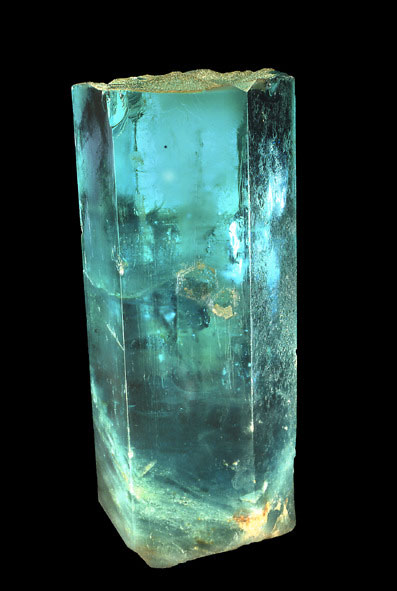 |
| The “Emperor of India” aquamarine is now in the collection of private Italian collector Adalberto Giazotto. (Photo courtesy Mineralientage München) |
The Munich show also features domestic delights—well, nearby, anyway. “Alpine Treasures: From the Mountain to the Display Case” will include 300 minerals from the Tyrol region that straddles the Austria–Italy border. The specimens, drawn from different, mainly private collections from the Naturmuseum Bolzano (Museum of Nature South Tyrol in northern Italy), will be accompanied by several anecdotal explanations of provinence and discovery. Professional crystal hunter Franz von Arx (English translation here) also will be on hand. Last year he c0-discovered huge crystals in a cave on the peak of Planggenstock in central Switzerland. Crystals weighing over 350 kilos each will be displayed. (Video stream of the crystals is available from Schweizer Fernsehen.)
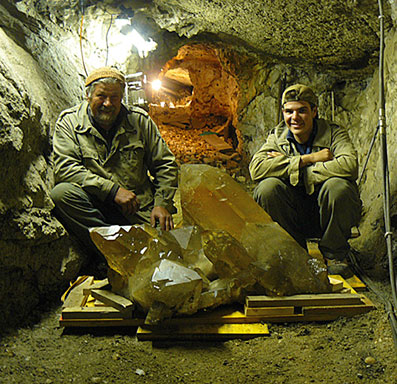 |
| Swiss crystals discovered a year ago by Franz von Arx, left, will be featured at this year’s Munich show. (Photo courtesy Mineralientage München) |
Natural stone has long been used for wall cladding, but “Natural Objects – Artistically Staged” will examine other creative uses such as backlit salt crystal walls and “stony artworks.”
For more information visit the show website. See the Pala International Show Schedule for future events. [back to top]
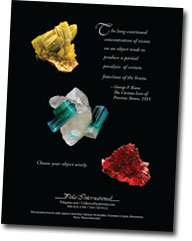 |
| See our ad in this year’s program. |
 |
Also in Germany: terra mineralia
celebrates a birthday
The remarkable collection of Dr. Erika Pohl Ströher—dubbed terra mineralia—celebrates its first birthday October 23–25 in its home at the famous Technical University of Freiberg in Saxony. According to the exhibition website:
The positive feedback and interest of the visitors has overwhelmed everyone, making the last year appear like a fairytale. Therefore the anniversary weekend is going to stand under the sign of fairytales with a specially designed mineralogical storyline. Can the copper-smith break the ban of the evil fairy sulphur flower with the help of magician Calcitus and find the heart of king Aquamarine? A heart that allows him to win princess Rubina over. More details about the program for young and old will follow soon...
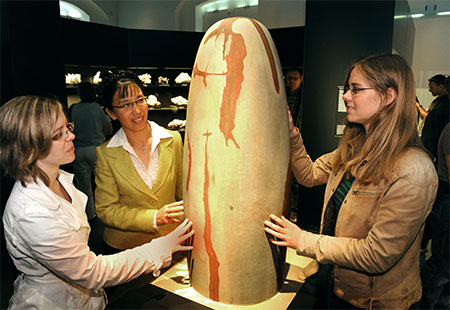 |
| Not from the Munich show (lest you think we slipped this in from the special India exhibition at Mineralientage München). Above, visitors examine a large Shiva lingam on opening day in the terra mineralia Asia hall. (Photo: Detlev Müller) |
Visitors to the Munich show will want to head north to see this collection, which we profiled in last October’s Mineral News. More than two-thirds of the collection’s 5,000 specimens remain on view. The collection, amassed over 60 years of collecting, is on permanent loan in Germany.
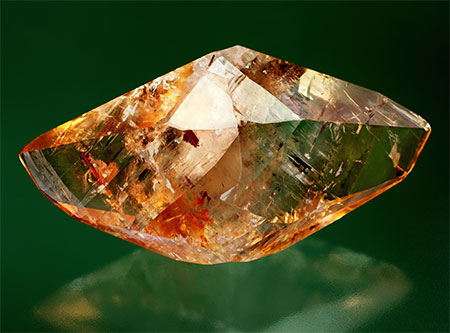 |
| Calcite, USA, size: 14 x 7 cm., from the terra mineralia exhibition. (Photo: Jörg Wittig) |
[back to top]
Specimens with Altitude
Pala’s Will Larson reports on the Colorado Mineral & Fossil Show
It’s that time of year again! The Denver show is here. It’s a hustle and bustle. Set-up day is always a cheer—well, once it’s over. The hallways of the Holiday Inn were crowded on opening day and people were moving between rooms: Make haste thy collectors! Reunited with friend and foe on the battlefield of business. The workplace has not changed with the passing of time; familiar faces and new ones to meet, and some new material was uncovered, too.
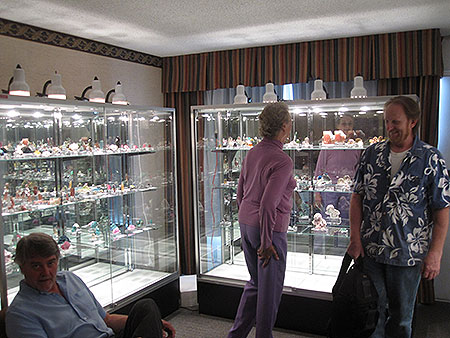 |
| Room 183. Pala’s Bill Larson, left, chats with Casey Jones as Dawn Minette browses the Pala International offerings at the Holiday Inn. (Photo: Will Larson) |
Grabbing our attention first, at the Holiday Inn show, were many colorless phenakite crystals from Nigeria, amounting to about one kilo in fellow Southern Californian John Garsow’s room. Intriguing, etched faces amplified these crystals; some weighed close to 100 grams. The supply of beautiful green andradite garnet crystals on matrix from Madagascar were again in supply. These garnets are mostly demantoid but we are finding out that some of the larger crystals turn out to be topazolite. Continuing through the Holiday Inn, Colorado’s Pinnacle 5 Minerals in room 103 had many wonderful specimens of amazonite on smoky quartz from the Smoky Hawk claim’s Smithsonian pocket in the state’s Teller County. One in particular was a beautiful cluster of amazonite and quartz all perfect with no damage, no repair, and with good size, about 3 inches by 5 inches across.
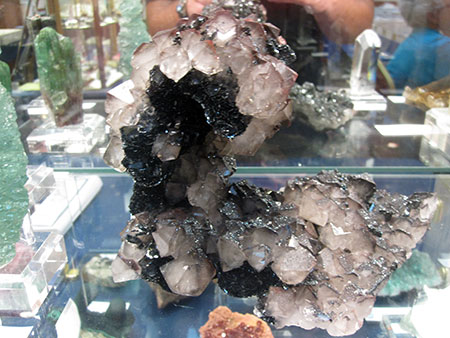 |
| “The Wave.” This quartz from Cumberland, England, sold quickly when it was offered by Texas dealer Doug Wallace of Mineral Search. (Photo: Will Larson) |
Into room 190 of the Holiday Inn, Czech Republic’s KARP Minerals had a private cache of large crystals of cuprite from Kazakhstan. One of the cuprite specimens was a tree-shaped copper; the cuprites were covering it and dangling down from the copper, quite pretty. Also a massive cluster of cuprite crystals that were very large, lustrous, and with very little damage. This was one of the most impressive cuprites I’ve seen.
 |
| Cuprite on copper. This specimen from Kazakhstan is offered by Pala through The Collector, Inventory #17460. (Photo: John McLean) |
Across the train tracks on the other side of the road is the Quality Inn. Here there are a lot of wholesale dealers with material from around the world. We saw a great amount of quartz and fossils but mostly commercial quality. What caught our attention was gorgeous fire opal from Mexico: beautiful opals that had all sorts of iridescent colors from reds to blues to greens, and the material ranged from beautiful white-blueish to the deep red material. One in particular caught my attention; it was a beautiful crystal with dots of colors all over it that sparkled in the sun.
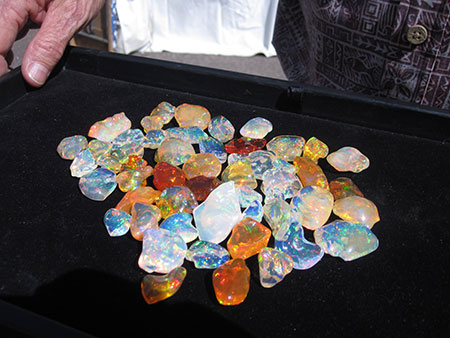 |
| Mexican opal. A wide variety offered by Ópalos y Artesanías Mexicanas, from Jalisco. (Photo: Will Larson) |
The Merchandise Mart
Everyone loves a good set-up day, and the Merchandise Mart’s was no exception. More cases and minerals, fossils and jewelry, everything you can imagine, going to and fro, from truck to booth. Display cases this year consisted of fine minerals from around the world. Special features were “Minerals that Do Things,” by the Junior Museum of Central Pennsylvania, and the replica of the Crown of the Bavarian Queen, exhibited by the Mineralogisches Museum am Steinmann-Institut from Bonn, Germany.
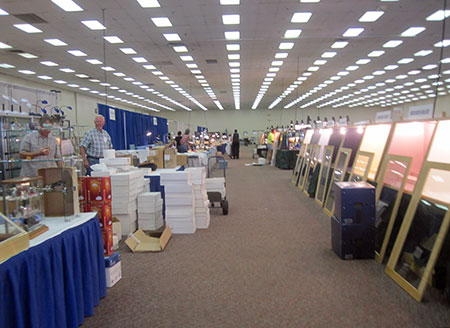 |
| Merchandise Mart. Setting up in the main hall. (Photo: Will Larson) |
Once again, collectors Scott Rudolph and Keith Proctor put on a beautiful display of fine worldwide minerals. New material on display at the Merchandise Mart consisted of a new find of Vera Cruz amethysts, which were a beautiful purple color on matrix, some of which were highly aesthetic with great form. Also from Mexico we saw a new find of aurichalcite in calcite; Rob Lavinsky and Arizona dealer Marcus Origlieri had these specimens, but sadly most had just enough damage to make the sophisticated collector have a very sad face. Marcus also had marshite (CuI) specimens, up to three quarters of an inch, that were found in a copper mine in Western Siberia near the Kazakhstan border.
Arkenstone’s Rob Lavinsky had some of the new matrix Namibian aquamarine and schorl specimens, but these were of a new size range I hadn’t seen before, ranging from about 5 to 10 inches across. Collector Marshall Sussman allowed us to peek through a wonderful collection of Namibian minerals he’d bought from another collector. In it were two fluorite spinel twins the likes of which I had never seen before. Because they looked like tourmaline pencils, I couldn’t get over the fact they were fluorites. Cool! We were also lucky to be shown by Rob and Marshall some amazing spike-balls of creedite that were a tan-orange color—also a new find from Mexico. My host in Germany this summer, Marcus Budil, had a room full of beautiful specimens from his trip to East Africa: the new topazolites and demantoids as well as some beautiful tanzanite crystals, small chrome tourmalines, and diopsides.
All in all, the shows were busy and people seemed excited to be in the mineral loop once again! Hope to see you all again soon in Munich!
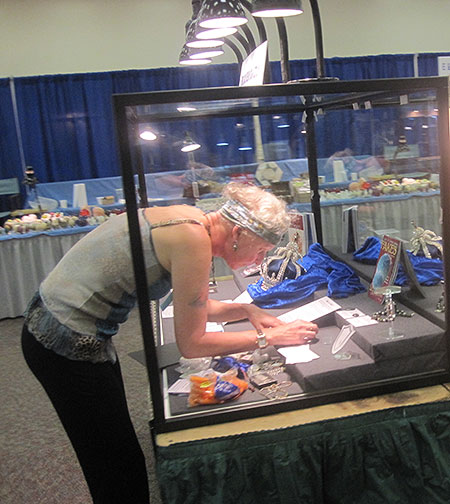 |
| The Denver Gem and Mineral Show at the Merchandise Mart features museum exhibitors from here and abroad, including the American Museum of Natural History, National Museums of Scotland, Royal Ontario Museum, Smithsonian Institution, Denver Museum of Nature and Science (two departments), and Mineralogisches Museum am Steinmann-Institut, pictured above. At center is a replica of the Bavarian Queen’s Crown. (Photo: Will Larson) |
[back to top]
Lyon Mineral Show Features Famous Larson Specimen
Iconic rhodochrosite graces exhibition poster
The 34th International Show of Minerals, Fossils & Gems, in Lyon, France, features on its poster a famous rhodochrosite from the collection of Pala’s Bill Larson. The unique specimen, known as the “Snail” for obvious reasons, hails from the N’Chwaning Mine in South Africa—the same locality as the rhodocrhosites that illustrate son Will Larson’s article about collecting below. The photograph was taken by Jeff Scovil, who is himself the subject of two videos available from BlueCap Productions.
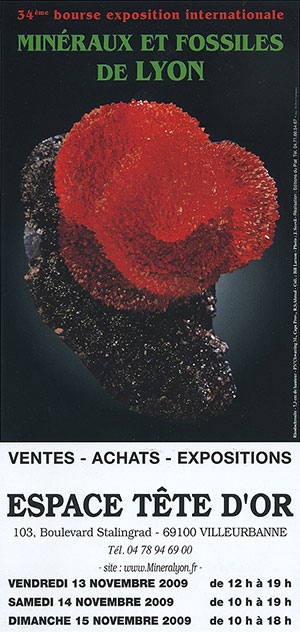 |
The Lyon show, November 13–15, will include 80 international dealers, minerals of the world from a private collection, thumbnail specimens from sevreal private collections, gems from the Association Française de Gemmologie, and more. Hélas, the only place l’Escargot célèbre will be displayed in Lyon is on the show’s poster… [back to top]
Sainte-Marie-aux-Mines Show Sees Continued Uptick
Troubled times ignore the mines
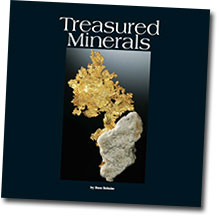 |
| Treasured Minerals by Russ Behnke is a free PDF download from the Sainte-Marie show website. |
The 2009 Sainte-Marie-aux-Mines show “exceeded all expectations,” according to a newsletter issued September 8 by the show’s organizers. “Despite a difficult period around the world, and the last minute scares due to concerns about an epidemic,” the report stated that “[the show] saw, yet again, an increase in the number of exhibitors and of visitors this year.” Visitors numbered 29,300—a third of them “professionals”—and 985 exhibitors representing 60 countries.
Photos of the 2009 show are available [since removed]. Also offered is a free PDF version of collector-dealer Russ Behnke’s 2008 book, Treasured Minerals. [back to top]
What’s Hot In Tucson – Online
Extra material trimmed from the 4-hour DVD
In conjunction with What’s Hot In Tucson 2009—BlueCap Productions’ 2-DVD recap of the Tucson mineral show—outtakes have been made available online for those who just can’t get enough. For 2009 the producers have added on-screen labels (as pictured below), and the streaming video format is larger and of higher quality than the sequences that made their debut last year.
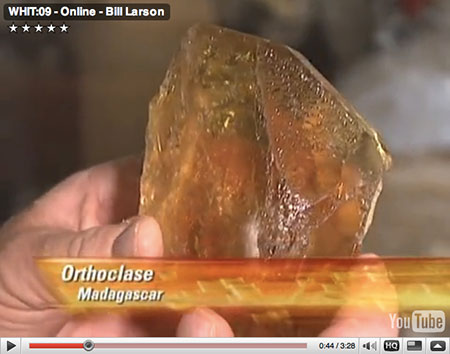 |
| If this is an outtake… Just a “little” something to prepare you for the DVD version of What’s Hot in Tucson 2009, which is available at a discount for Pala pals (see details below). This roughly 1-kilo orthoclase came out of the personal collection of… well, you’ll have to see for yourself—and select the HQ button for the best quality. (Image courtesy BlueCap Productions) |
The free video clips are available here. Clips are added on a regular basis.
And remember, friends of Pala International get a 10% discount on any BlueCap order. Just enter the code palaintl when you’re asked for it while ordering. Visit BlueCap Productions for the full line of offerings, including Capturing the Minerals: Three photographers’ perspectives, profiling the work of Michael Bainbridge, Joe Budd, and Jeff Scovil.
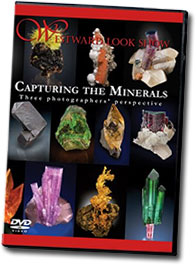 |
[back to top]
Pala International News
Pala’s Featured Mineral Specimen: Kearsarge Lode Silver
This month we feature a pleasant little silver from the Kearsarge Lode in Michigan. This is a crystaline specimen that seems to branch out like a tree, with roots and all. Very aesthetic cluster that would work well in any metals or USA collection.
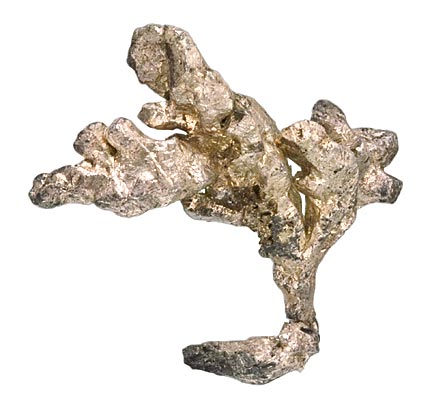 |
| Shake a tail feather. Silver shown at two different angles. Dimensions: 42 x 38 x 10 mm. Weight: 25.2 grams. There is an “odd” perspective in the photo below. Can you see the rooster? He’s waving at you. (Photos: John McLean) |
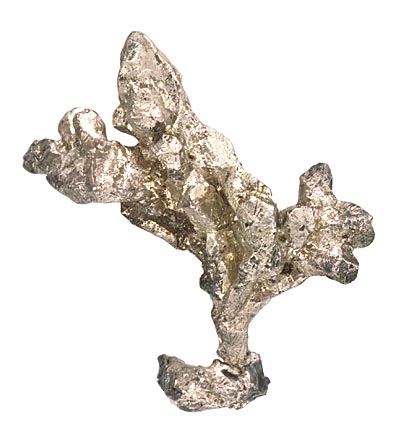 |
The Kearsarge Mine is in northwest Michigan, in the Keweenaw penninsula, and produced large amounts of copper starting in 1886. Peak production occurred between 1887 and 1897, in the form of 14.5 million pounds of refined copper. These mines also produced some of the best silver specimens in the Keweenaw region. The entire mine was eventually closed in 1956. More info from Mindat.
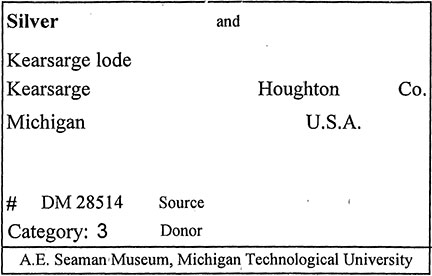 |
| Vintage label from the A. E. Seaman Mineral Museum at Michigan Tech. |
A Portrait of the Collector as a Young Man
Will Larson to be “Collector Day” guest
at 2010 Westward Look Mineral Show
It’s not too early to be thinking about next year’s Westward Look Mineral Show at Tucson. In anticipation, we’re taking you behind the scenes of Will Larson’s Japanese and worldwide collections, which will be in the annual “Collector Day” spotlight, on Saturday, February 6, 2010.
The Japanese collection
In 2004 I traveled with my classmate Shoko Miyazaki to Japan for the first time during my senior year in high school for spring break. Spring is one of the most beautiful times in Japan, as the sakura (cherry blossoms) are blooming. Later that fall I started my freshman year at Santa Clara University, where I decided to take Japanese for my language requirement, which I continued for three years and received a minor in Japanese language. I fell in love with the country as a whole and returned for six more trips by myself to Japan, some for business, others for pleasure, and once to study abroad.
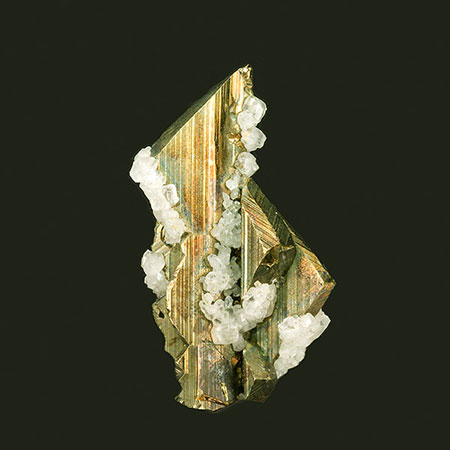 |
| Chalcopyrite, Arakawa Mine, Ugo (Akita Prefecture), Japan. While in Gene Meieran’s collection this specimen won the Lidstrom award at Tucson. From Will Larson’s Japanese collection. (Photo: Mia Dixon) |
After my first visit to Japan, when I attended mineral shows I began to pay attention to specimens from Japan and realized how rare and difficult-to-get Japanese minerals really are. During my travels, I made a point of visiting museums to see what kind of material was produced in Japan, since much of it was unearthed before I was born. In 2006 I went back to Japan for the 19th International Mineral Association conference, in Kobe, Japan. During this trip I visited the Ikuno Silver Mine in Hyogo Prefecture, with Bunno-sensei. At this mine is a mineral museum that houses the famous Tunashiro Wada collection, which is one of the best preserved collections of Japanese minerals in the world. The Wada collection has everything from fantastic blue topaz, to large orthoclase crystals, to beautiful chalcopyrite. It also has one of one of the largest Japanese stibnites I’ve ever seen, standing a meter tall. Therefore, I came to find that much of the material is in museums or private collections and not for sale. This scarcity has challenged me and ignited my passion to collect Japanese minerals.
In 2005 I began working the Tokyo Mineral Show in Ikebukuro and picked up some small Japanese minerals, but nothing to speak of. The first major addition of Japanese specimens to my collection was in Tucson when SoCal dealer Casey Jones had a group of four fine Japanese minerals which were turned down by a customer. This allowed me to trade Casey a few of my worldwide specimens for these four pieces—danburite, orthoclase, chalcopyrite, and a Japan-law twin quartz. Westward Look show founder Wayne Thompson also helped me out with a beautiful chalcopyrite twin on pyrite, which he probably could have sold for double.
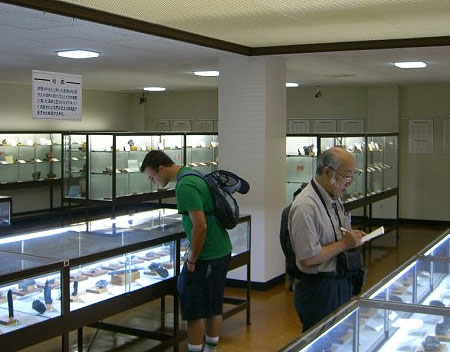 |
| Study hall. Will Larson, above left, and fellow traveler Bunno-sensei inquire why Japanese mineral specimens are all too rare: they’re all in the Wada collection! Pictured below is a foot-long stibnite specimen. (Photos: Will Larson) |
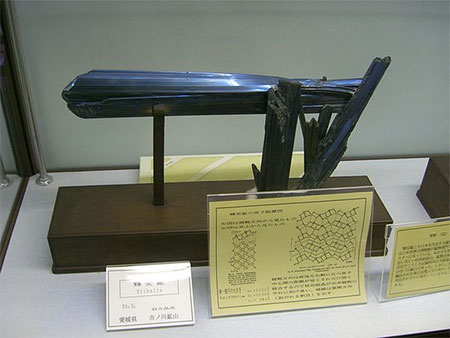 |
Ikebukuro the next year was good to me, as I approached the local firm Komuro Minerals for Japanese specimens and was able to purchase three beautiful rhodochrosites, all of which have different colors and forms. I also received a few pieces from the Grieger Collection, including one very nice stibnite. I saw a few pieces in the Gene Meieran Collection, which I admired very much. Later I was able to acquire the Lidstrom (best in Tucson Show) award-winning chalcopyrite from Gene’s collection in Denver thanks to Rob Lavinsky, as he let me trade for it. Rob has had the biggest impact on my collection because he understood that I was young and could not afford the minerals, and was willing to work with me. I also was lucky enough to have many self-collected specimens that Rob could sell and take on trade to help finance my Japanese mineral collection.
My good friends, collector Moriyama-san and his wife, also have been very kind to me throughout the years; I have not been able to get many specimens from him as he deals mostly in fluorite, but at this year’s Denver show he gave me a fine quartz crystal, one of only four in the find. Also at Denver this year I purchased from Marcus Origlieri a fine danburite cluster, and San Diego County dealer Donald Olson helped me with some andesine twin crystals, which he gave me along with some orthoclase crystals that were keystone. I continue to try and find new things at each show—if not to buy, then to study and learn their locations.
The worldwide collection
Of course, my collecting didn’t begin with Japan. You could say I’ve been collecting minerals since I was born. I was 8 months old for my first Tucson show at the Desert Inn and Tucson Gem and Mineral Show in 1986, and since then I have not missed a Tucson show. My worldwide collection is a culmination of what I was able to assemble, thanks to the many people who have helped me throughout my youth in the mineral business as well as those who were willing to work with what I had. I have bought, sold, and traded ever since I can remember.
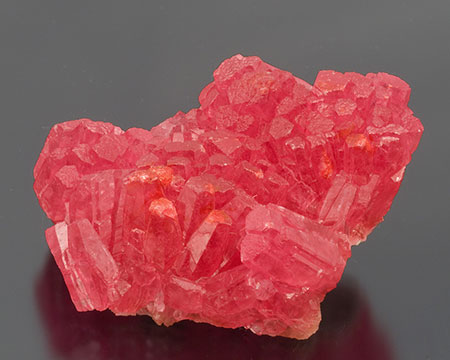 |
| Rhodochrosites, N'chwaning Mines, Northern Cape Province, South Africa, demonstrating the variations found in a single locality. The specimen below features quartz druse. From Will Larson’s worldwide collection. (Photos: Mia Dixon) |
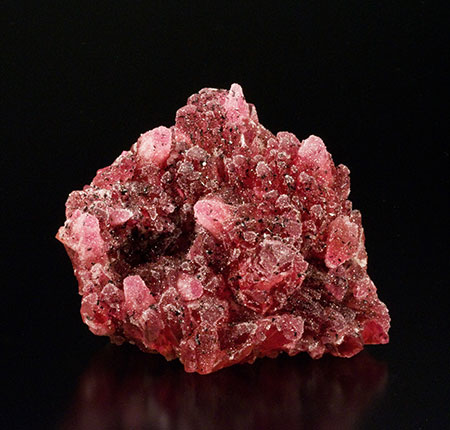 |
Major additions to my collection began at the age of twelve when I was able to go on an epic adventure with my father to Burma, Vietnam, and Thailand. On this trip I was allowed a certain percentage of trade for the the goods we had purchased in Southeast Asia and sold, much of which I spent with New York dealer Stuart Wilensky. Thanks to his purchase of the material I was allowed to select pieces I liked and that greatly added to my worldwide collection. Some of these specimens were later traded to acquire Japanese minerals. I also collected Colorado minerals thanks to Arizona dealer Evan Jones who sold me a suite from his collection at a very reasonable price. I continued to build on this collection until I turned my focus towards Japanese minerals. Therefore I retain a heavy influence of Colorado specimens in my worldwide collection today.
I have been blessed with the ability to travel a lot and all over the world. My many trips to Burma and Thailand have allowed me to acquire gems and minerals that I have added to my collection, or used to trade for other pieces. Through all of these life-changing experiences I have been able to build up a collection of many minerals from around the world. The enjoyment of it all has been a dream.
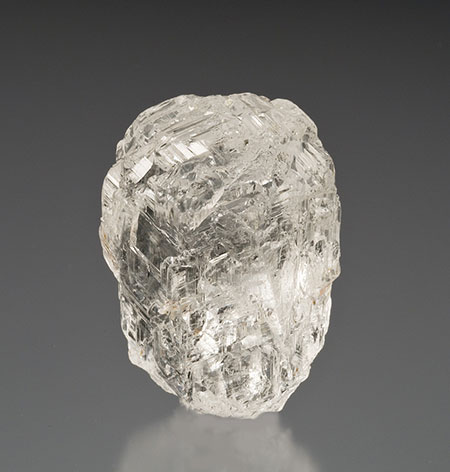 |
| Phenakite, Jos, Nigeria. From the Shining Stone (aka Salistone) mine—Okuta Didan in the Yoruba language. From Will Larson’s worldwide collection. (Photo: Mia Dixon) |
[back to top]
We Get Mail…
Here’s a sampling of mail we’ve received over the last few months and years. Note: Affiliations are for identification only; they should imply no endorsement by an organization or institution.
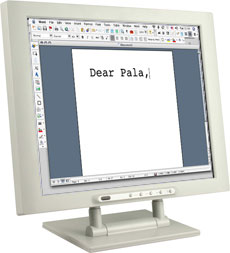 |
To: Jason Stephenson & Nikolai Kouznetsov. Gentlemen, thanks for the great article on demantoid in the recent InColor magazine! It helped me trace the provenance of a vial of “Ural Pearls” from “Bobrowski, Ural Mts.” the museum accessioned in 1902! Running across this cryptic locality attribution, I immediately thought of your article and, sure enough, your reference to Bobrovka River panned out. Thanks for the help! —Marc Wilson, Head, Section of Minerals, Carnegie Museum of Natural History
Hey Bill! Surprise! I wanted to express my gratitude for your making so much information available to the mineral collecting community. —Victor Yount, collector and dealer in northern Virginia
Hi Bill. Enjoyed your recent posting re 40th year in business. My, how time flies! That annual “Mine Bash” and Shop Party was always the beginning of Tucson Madness Week. And how Bill and I appreciated being included in the fun! Such fond memories. I wish you well and am so pleased to know your sons are following in your footsteps. That is quite a tribute to you as a father. My best to all. —Elizabeth Moller, who with her late husband Bill won many an award for their mineral collection at Tucson (and elsewhere)—in fact celebrating their 60th wedding anniversary at the show in 2006
Bill: Congratulations on the 40th anniversary of Pala Int’l! I dare say I was only 14 when it was founded but have been around to watch it grow over these many years! I don’t know if I should be happy or sad about the incredible scepter found at Foster’s claim this season! I thought mine was one of the best around until this one (the best one I’ve ever seen from the mountain) was unearthed! However, I’m still happy to have the one I’ve got anyway! Once again, congratulations and continued success! —Michael T. Evans, Instructor of Gemology, Gemological Institute of America, referring to the smoky amethyst quartz scepter featured in our June newsletter
Thank you, yet again, Bill Larson, John McLean, and Jason Stephenson for another brilliant Mineral News. Superb photography as always and text. Always look forward to these emails appearing on my screen. Keep up the good work. Very sincerely, Hylda. —Hylda Bracewell, The Australian Gemmologist, in response to our April 2007 newsletter
And the following letters relating to minerals were included in last month’s Gem News from Pala International.
Thanks for the nice plug of the latest G&G on Pala’s newsletter! Much appreciated…. Pala’s newsletters are the best electronic newsletters I receive regarding the gem and mineral trade. Keep up the great work! —Brendan Laurs, Editor, Gems & Gemology, in response to our August Gem News mention of G&G at 75
I want to commend you on your monthly email of mineral news. I read every issue start to finish and always learn new things. You do a great job at combining various articles with diverse subjects. Keep up the good job! —John Betts, of John Betts Fine Minerals, New York
Again, compliments and congratulations on a superb, presentation [regarding our June 2007 Mineral News]. —Lawrence H. Conklin, Mineralogist, who is celebrating his 52nd year as a full-time buyer and seller of mineral specimens
And on the lighter side…
Be sure to catch the new items in Pala’s Mailbag. [back to top]
Mineral and Mineralogy News
Chips & Chunks
Video: Petra’s 507-carat diamond from all the angles
By now you’ve heard about the 507.55-carat colorless diamond unearthed at the famous Cullinan mine in South Africa by Petra Diamonds, a consortium that bought the mine from De Beers, as we reported in December 2007. Der Spiegel posted video that provides a 360-degree view of the stone.
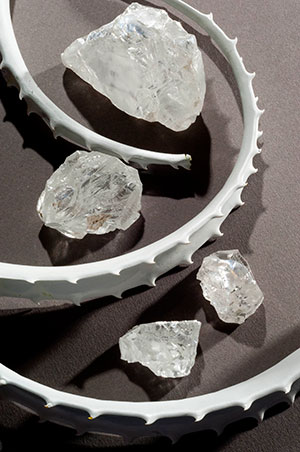 |
| Fab four. The four recently unearthed white diamonds from the Cullinan mine in South Africa. (Photo courtesy Petra Diamonds/Buchanan Communications) |
Also “recovered,” as a MiningWeekly.com story oddly phrased it, were three other diamonds, from the same production run, “of similar colour and clarity.” Pictured above, they weighed in at 168, 58.5, and 53.3 carats. [back to top]
Don’t take any wooden moonrocks
Rijksmuseum Amsterdam—home to masterpieces by Vermeer and Rembrandt—issued an “oops” late last month when it was revealed that a rock brought back by U.S. astronauts was a fake.
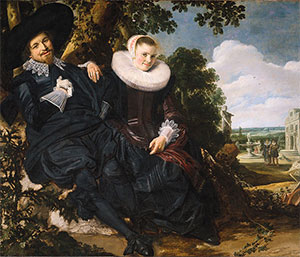 |
| Aw, shucks. We was only kiddin’… |
The rock’s story dates back exactly 30 years, when former Prime Minister Willem Drees received it following the Apollo 11 crew’s “Giant Leap” tour of 25 foreign countries in the summer of 1969. The gift was given by J. William Middendorf, U.S. Ambassador to the Netherlands, who received it from the State Department. A call to NASA by the museum, which acquired the rock after Drees’s death, confirmed its authenticity. In 2006, while it was on display at the museum, a space expert questioned the likelihood of NASA parting with actual material from the moon. And one thing led to another…
See AP for story and photo. [back to top]
Changing Rooms at Elephant and Castle
Remember those ancient days of 1996 and BBC’s Changing Rooms, when reality TV seemed almost quaint instead of annoying? Now British artist Roger Hiorns gives new meaning to the term extreme makeover. Hiorns has taken a neglected council flat in south London, near Elephant and Castle, and done the unthinkable—with mineralogical flair.
The public housing bedsit was simply made airtight and filled with a copper sulphate solution for three weeks. The result, Seizure. Seeing is believing:
- Process: Iconeye
- Background: Guardian
- Deep Background: Evening Standard
- Pix+Vid: shape+color
- Commission: Artangel
- Portfolio: Corvi-Mora
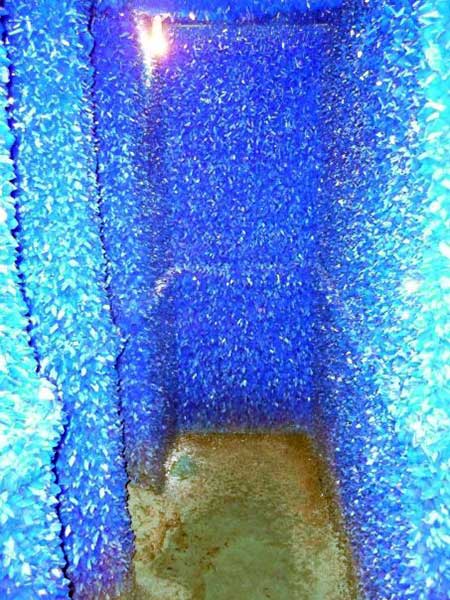 |
| Siezure, by Roger Hiorns. (Photo: Corina Kellam) |
Hiorns has been nominated for the prestigious 2009 Turner Prize, which will be announced December 7. The installation is available for free public viewing until October 18. [back to top]
Only in Hollyw… Orlando? “Bahia” Emerald: The Movie
Yes, there is a Hollywood, Florida (in the greater Miami metro area), but this story takes us to the Orlando suburb of Altamonte Springs, where a press conference was held last month to announce plans for an “high-volume rollercoaster ride” of a movie based on the infamous “Bahia” Emerald, which we last reported on in March.
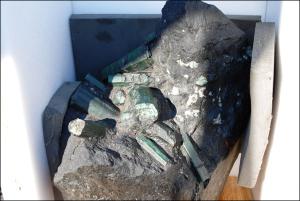 |
| “Bahia” Emerald. Rollercoaster-ready. (Photo: L.A. County Sheriff) |
The film is to be shot and edited entirely in Florida. Why? The film’s story involves “finding, moving, and protecting the 180,000 carat, $372,000,000 ‘Bahia Emerald’ from those seeking to take it away from the Florida owners,” according to a notice posted in a Septembe 25 state government newsletter. “‘Although [the emerald] secretly moved from a remote part of Brazil to its present location in a California Superior Court case lockup, Florida played the major role in the story,’ said Corey Park, Managing Partner of Emerging Growth Funding, LLC which funded principal photography.” Park went on to claim that “all those involved were Floridians, and most of the negotiations for selling the gem took place throughout Florida….”
That’s the first we’ve heard of a Florida connection, but then, news about the 840-lb. specimen isn’t easy to come by. Perhaps we should ask Larry King. The television talk show host is said to have had the book rights to the specimen’s saga snatched from underneath him. Park explained: “TV host Larry King tried for the book rights, but we made the point that Florida is a solid alternative to filming elsewhere.” It seems that keeping the book rights in the Sunshine State is part of the “all-Florida” design. For more on the plans see the official website. [back to top]
— End October Newsletter • Published 10/5/09 —
August 2009 Newsletter
Shows and Sales
- Pala at Colorado Mineral & Fossil Show – Sept. 16–20, 2009
- East Coast Gem, Mineral & Fossil Show
- Sainte-Marie-aux-Mines 2009: A Report by Bill Larson
- L’avant-garde in Sainte-Marie: A Report by Will Larson
Pala International News
Mineral and Mineralogy News
- Chips & Chunks
- Greenland’s Nod Towards Independence Means Ruby Rights for Indigenous
- “El Itoco” and El Botero
Shows and Sales
Pala at Colorado Mineral & Fossil Show
September 16–20, 2009
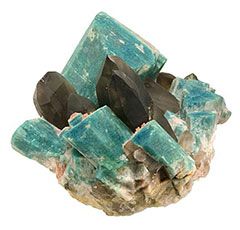 |
| Amazonite from Yucca Hill in Colorado, 6.4 x 10 x 8.5 cm. This specimen is available. (Photo: John McLean) |
Pala International will be at the Colorado Mineral & Fossil Show.
- When: Sept. 16–20, 2009
- Where: Holiday Inn Denver–Central, 4849 Bannock St.
- Room 183
- Hours:
Wed.–Sat.: 10 a.m.– 6 p.m.
Sun.: 10 a.m.– 5 p.m.
We look forward to seeing our many friends there. For more information visit the show website.
Visit the Pala International Show Schedule for future events. [back to top]
East Coast Gem, Mineral & Fossil Show
Spanns featured exhibitors at Springfield show
Note: We had hoped to send our August Mineral News out before last weekend, but were delayed. We hope the information here will be of interest nonetheless.
Last weekend West Springfield, Massachusetts played host to the East Coast Gem, Mineral & Fossil Show, with 200 dealers from across the country offering their selections. The show included 55 wholesale dealers as well.
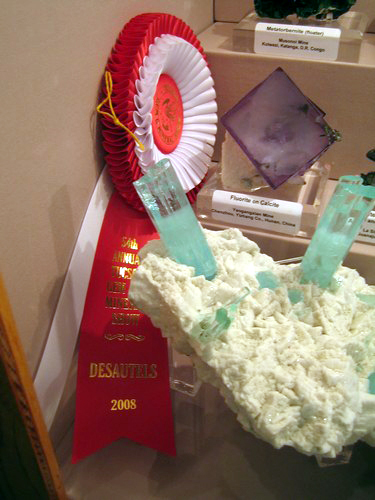 |
| It’s a winner. Gail and Jim Spann, who received 2008’s Desautels Trophy in Tucson, are featured at this year’s East Coast show. See a copiously illustrated report on the 2008 trophy at The-Vug.com. (Photo: Above, Brandy Naugle, courtesy The-Vug.com) |
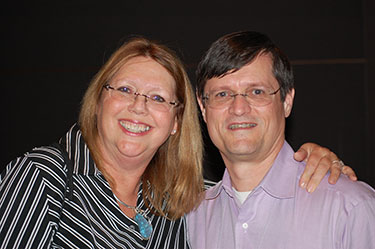 |
Featured this year was the collection of Gail and Jim Spann of Rockwell, Texas, who have assembled upwards of three thousand specimens in only five years, making this their eastern seaboard debut. And, apparently, the family that collects together stays together: the Spanns discussed their secrets on Saturday afternoon.
Previous featured collections have included those of Herb and Monika Obodda, the Sterling Hill Mining Museum, the Harvard Mineral Museum, Seaman Mineral Museum, Dawn Minette, Dan and Dianne Kile, amongst others. We’re pleased to note that in 2010, the 53 featured showcases of the East Coast show will contain selections from the collection of Bill Larson. Meanwhile, you can look for Bill this weekend on floor of this year’s show.
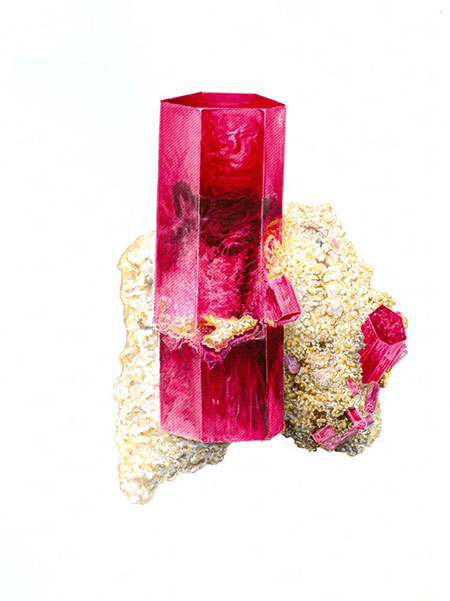 |
| Red beryl. Gemstone and mineral illustration is a time-honored tradition amongst collectors, as may be seen in this rendering of a Spann specimen, by Bay State native Fred Wilda, who also showed at the East Coast show. Gail Spann carries on the tradition herself; her watercolors accompanied the couple’s featured exhibition. (Illustration: Fred Wilda, courtesy Martin Zinn Expositions) |
[back to top]
Sainte-Marie-aux-Mines 2009
Bill Larson reports on this year’s show
I arrive in Frankfurt Tuesday morning, June 23, with fellow gem dealer Mark Kaufman and my son Carl. A bright summer day and we head for Sainte-Marie around noon. We proceed to miss the very same turnoff we had two years ago! Being a bit late we head directly to Sainte-Marie’s Super U store to buy groceries. While shopping, I get a call from Marcus Budil saying, “Bring beer and come to the theatre”—l’Espace Prestige, as the local theatre is known when it plays host to the finest exhibitions of the show.
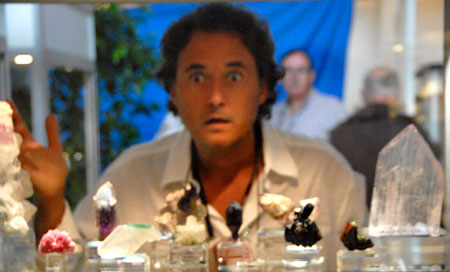 |
| GoodGobin. Christophe Gobin, looking through his display case, has just been informed he’s had the BadGobin title swapped with his brother Brice. The Gobins are Pala International’s “French connection” in Dubai. (Photo: Carl Larson) |
We find a close parking spot and deliver a six-pack of fine Fischer French beer. The theatre is already 50% full, with the dealers having set up already; every year the dealers set up earlier and earlier. My other son, Will Larson, has traveled down from an extended visit to Europe, mainly as a guest of Marcus Budil. He has lots of tales to tell us… Read the full story here.
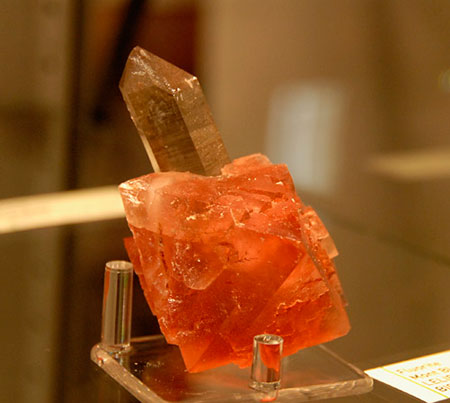 |
| Smoky quartz in pink fluorite from the Sainte-Marie show. (Photo: Carl Larson) |
L’avant-garde in Sainte-Marie: A Report by Will Larson
Bill’s son, Will Larson, having spent the summer in Europe in the company of, amongst other Mineralmänner, connoisseur Marcus Budil, arrived several days before opening day, and contributes his own report on the Sainte-Marie show.
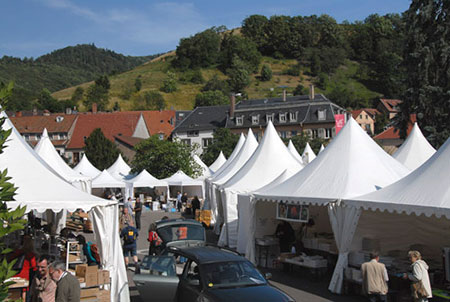 |
| Pleasure faire. The peaked display tents of the Sainte-Marie show enhance the medieval atmosphere of this Alsatian commune, which dates its mining history to at least the 3rd century C.E. (Photo: Carl Larson) |
[back to top]
Pala International News
Pala’s Featured Mineral Specimen: English Calcite Cluster
This month we feature a delightful calcite cluster from the Bigrigg Mine in the Cumberland region of England. Calcites such as this one have been collected and revered in England dating back to the 1800s. Intricate clusters and transparent scalenohedral crystals have defined these calcites as world-class specimens. Since many of the mines around Cumbria have been closed since the 1950s, these stunning calcite clusters are highly desired amongst collectors, rarely appearing on the market. The piece is ex Francis Benjamin, the prestigious collector from Bordeaux.
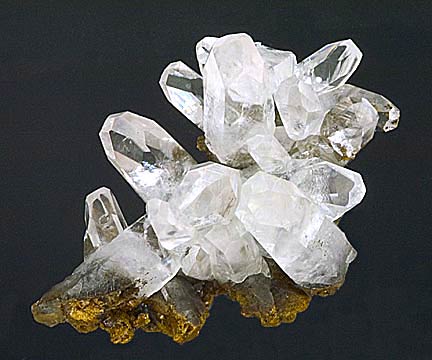 |
| Calcite cluster from the Bigrigg Mine, Cumberland, England, 4.9 x 9.6 x 5.8 cm. Inventory #17577. (Photo: John McLean) |
Here is your chance to grab a part of England’s historical calcite bounty. This is an exquisite cabinet specimen with randomly oriented individual crystals ranging from 3.5 to 1 cm. on a dark brown clay matrix.
Interested? Email us, select the inventory link above, or give us a call. [back to top]
Mineral and Mineralogy News
Chips & Chunks
Greenland’s Nod Towards Independence
Means Ruby Rights for Indigenous
 |
| Southeast coast of Greenland, across the tip of the landmass from the new rubyland. (Photo: Wikipedia) |
In our May issue of Pala’s Gem News, we pointed to a story that discussed issues surrounding commercial gem-quality development of ruby in southwestern Greenland. Inuit ruby hunters, however, through acts of what we called “geological civil disobedience,” were flouting the commercial developers’ exclusive rights by surface mining on licensed land.
Disobedient no more, the Inuit gleaners have had their practice favorably sanctioned by election of a new government in June. Our correspondent William Rohtert fills us in.
My contacts on the ground in [Greenland’s capital of] Nuuk say the populace was “euphoric, ecstatic, jubilant, literally dancing in the streets.” Not only was all-important control of Justice and of Minerals transferred to the Greenlanders, but a major shift in political power simultaneously occurred at Parliamentary level.
A 30-year “stranglehold on power” (in the words of The Economist) by the Siumut party’s social democrats, following an expense account scandal that might make Wall Street envious. And, as Rohtert continues,
… the opposition, known as the Inuit Brotherhood, was swept in by a 2:1 landslide.
One of the first moves of the Inuit Brotherhood was to direct the Ministry of Minerals and Petroleum (BMP) to incorporate native rights to ruby into national mineral policy. This is a 180-degree, about-face reversal of protocol by the BMP which had, heretofore, excluded the native Inuit from the ruby business instead favoring exclusivity of foreign mining companies. The move has been interpreted as a “victory for the little guy,” or at least as a harbinger for a new and positive climate for the Greenlanders’ small miner’s associations and their ruby artisans known as the 16 August Union.
Prior to the change, native people actually claimed they had the right to prospect under Section 32 of the Greenland Mineral Code, as explained by 16 August Union’s Niels Madsen in an April 16 report by fair-trader Marc Choyt. Madsen argued that the commercial developer, True North Gems, was only involved in exploration (exporting the rubies to testing facilities, according to Choyt), whereas Madsen’s prospecting was a tradition already in place. As Rohtert tells us,
This story is significant because BMP policy has prevented native Greenlanders from marketing natural ruby in volume and quality of interest to the international gemstone trade.
According to Choyt, the BMP until 2007 actually had encouraged mining on a small scale. The new government appears to be returning to its own tradition with the new rules. [back to top]
“El Itoco” and El Botero
Bowers Museum to Exhibit Emerald Crystal
with Colombian Artist’s Retrospective
In Pala’s Gem News for March, we noted the display of a remarkable emerald crystal at GIA. Southern Californians (and visitors) will get another chance to see this crystal, known as “El Itoco,” in conjunction with a retrospective of the work of Colombian artist Fernando Botero, at the Bowers Museum, September 13 through December 6. (Note: The emerald will be displayed only for the first six weeks of the Botero show.) Ronald Ringsrud, who facilitated the loan of the emerald, gave us the information that follows.
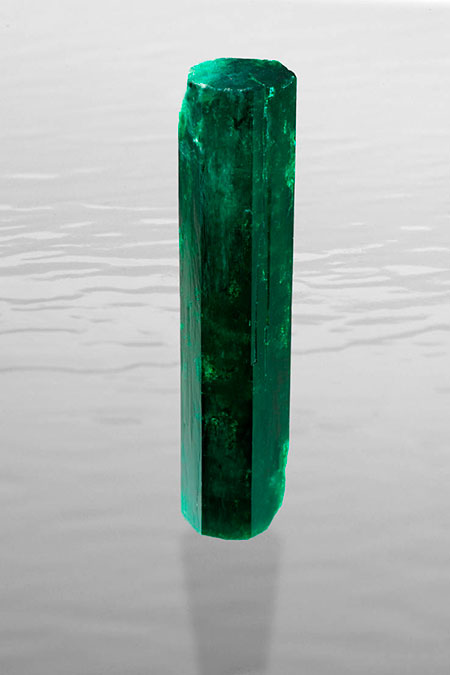 |
| Itoco Emerald, 472 carats, 1 x 4 in. (Photo: Robert Weldon, courtesy Ron Ringsrud) |
This 472-carat rough Colombian emerald from the La Pita mine is the largest and finest single crystal that has been mined in decades. Mined in August 2008, it represents the culmination of an emerald bonanza that yielded over 300 million dollars of emeralds from Muzo and La Pita in just over a year. The emerald will be put on display at the Bowers Museum for the first six weeks of the Fernando Botero exhibit on September 12.
The owner, Hernando Sanchez is a significant shareholder at La Pita, Consorcio, Muzo, and other mines in Colombia’s state of Boyacá. He wanted the crystal to be given a name that reflects the cultural history of the emerald mining region in Colombia. (Sanchez is mentioned on p. 294 of Ringsrud’s new book, Emeralds, A Passionate Guide.)
Itoco is the name for a promontory visible from the Muzo emerald mine, as well as a stream that washes the mine tailings. It is said that Itoco was the offspring of Fura and Tena, who were responsible for the creation of the world as it was known to the Muzo Indians, the first tribe of Indians to mine emeralds from those mountains.
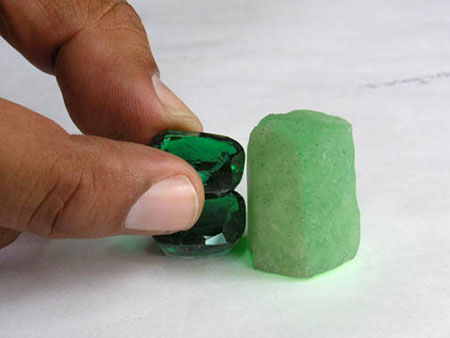 |
| Let’s compare. El Itoco is nearly three times the size of a similar crystal that was cut in October of 2008. Pictured above are two of the three 20-carat stones that came out of the 1-1/2 inch rough. The rough was so valuable that a plastic mold was made in the course of planning the cutting strategy (pictured above). These two faceted emeralds sold for almost $500,000, and the third cushion, $350,000. Ringsrud was there when it took place. (Photo courtesy Ronald Ringsrud) |
The crystal measures four inches tall and one inch wide. It is all gem quality. In Bogotá, a 1-1/2 inch piece of very similar material was cut into three 20-carat cushion cuts that sold for $850,000 within days after cutting—which gives a perspective on understanding the $3 million dollar value of the Itoco.
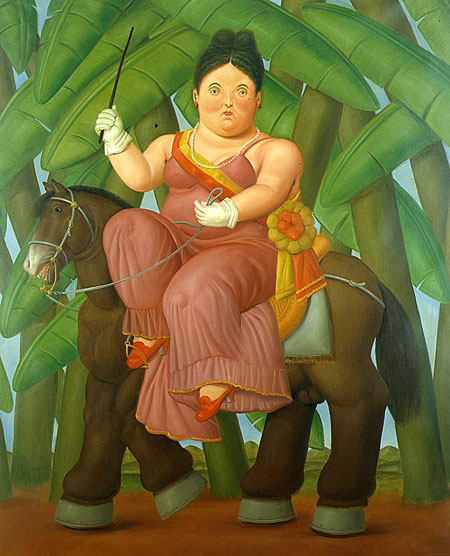 |
| Fernando Botero, The First Lady (1989), oil on canvas. (Private collection, courtesy Bowers Museum) |
The Colombian artist Fernando Botero is well known to aficionados of Latin American art—perhaps too well known. His signature paintings of rotund, impossibly proportioned figures are so recognizable that, according to Denver Post critic Kyle MacMillan, the touring retrospective “does not include one top-level American museum or any that focus on contemporary art.” Cautioning against misplaced snobbery, MacMillan plainly states that “[w]riting [Botero] off as a commercial sell-out or quaint picturemaker is just plain short-sighted” and goes on to describe some of the surprising subject matter in the 77-year-old artist’s work. (We won’t spoil the surprises, but MacMillan can fill you in here.)
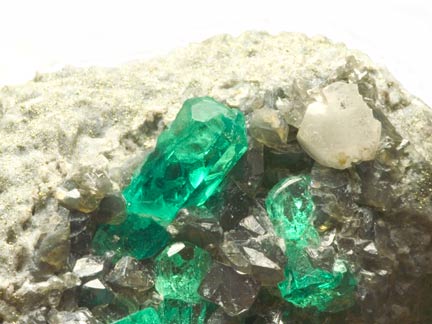 |
| Detail of an emerald specimen from Muzo, Colombia. The largest crystal measures 1.5 cm. The crystal has six well-formed sides and termination. The matrix sparkles with pyrite. It’s available. (Photo: Jason Stephenson) |
Ron Ringsrud, who makes his second home in Colombia, is quite familiar with Botero, and his comments follow.
When Botero donated his collection of paintings to Colombia, it was valued at $600,000,000. It is housed in the Casa de la Moneda/Botero Museum in downtown Bogotá (1-1/2 blocks from my house there). It has about 50 Botero paintings and sculptures but also three Picasso oils, three Picasso drawings, a Salvador Dalí sculpture, Miró, Calder, Renoir, and my favorite—the Flying Clown by Chagall. An amazing collection. Botero said he wanted young Colombian artists to see actual masters’ paintings and to see their brush strokes. [back to top]
— End August Newsletter • Published 8/11/09 —